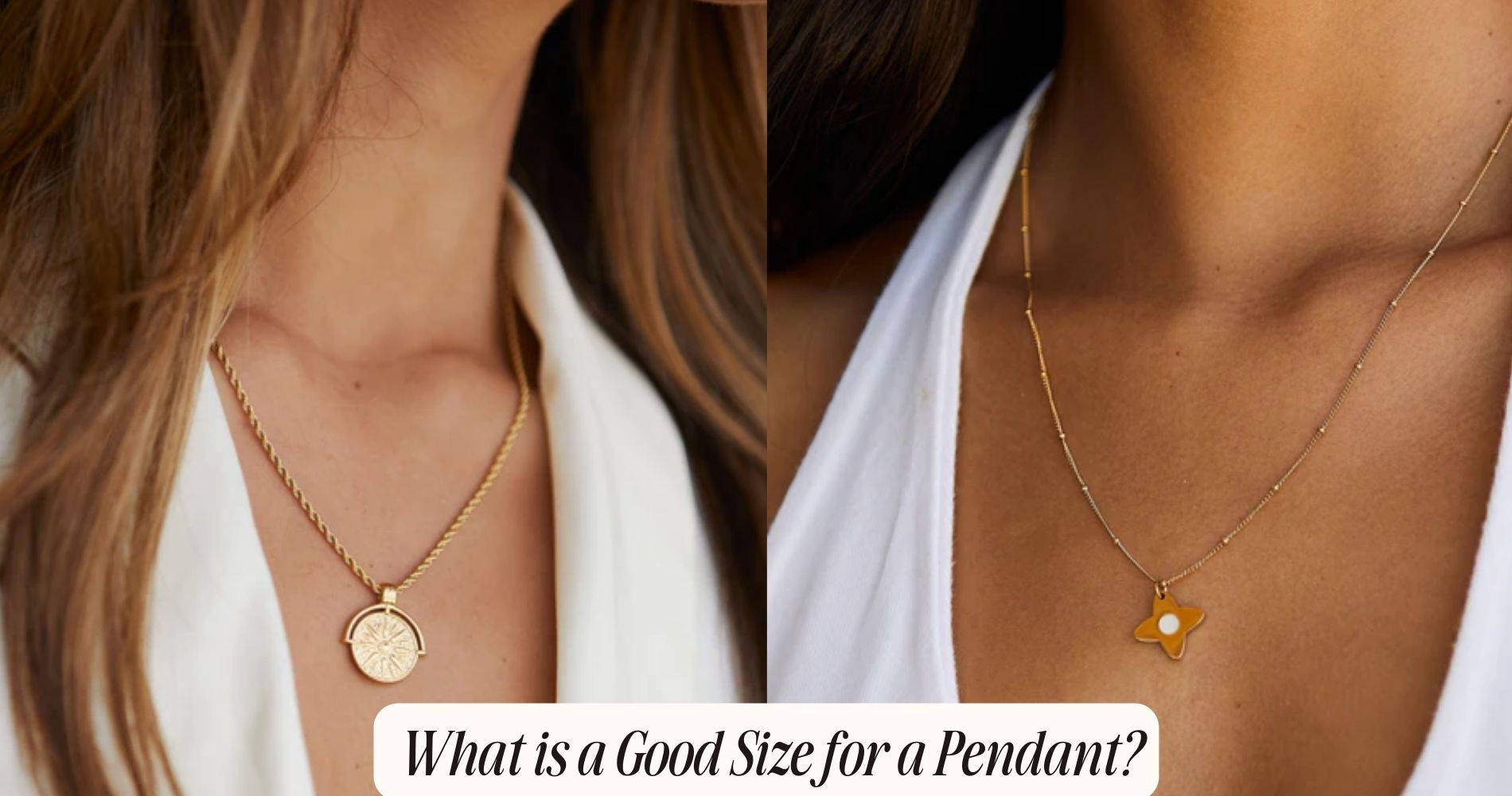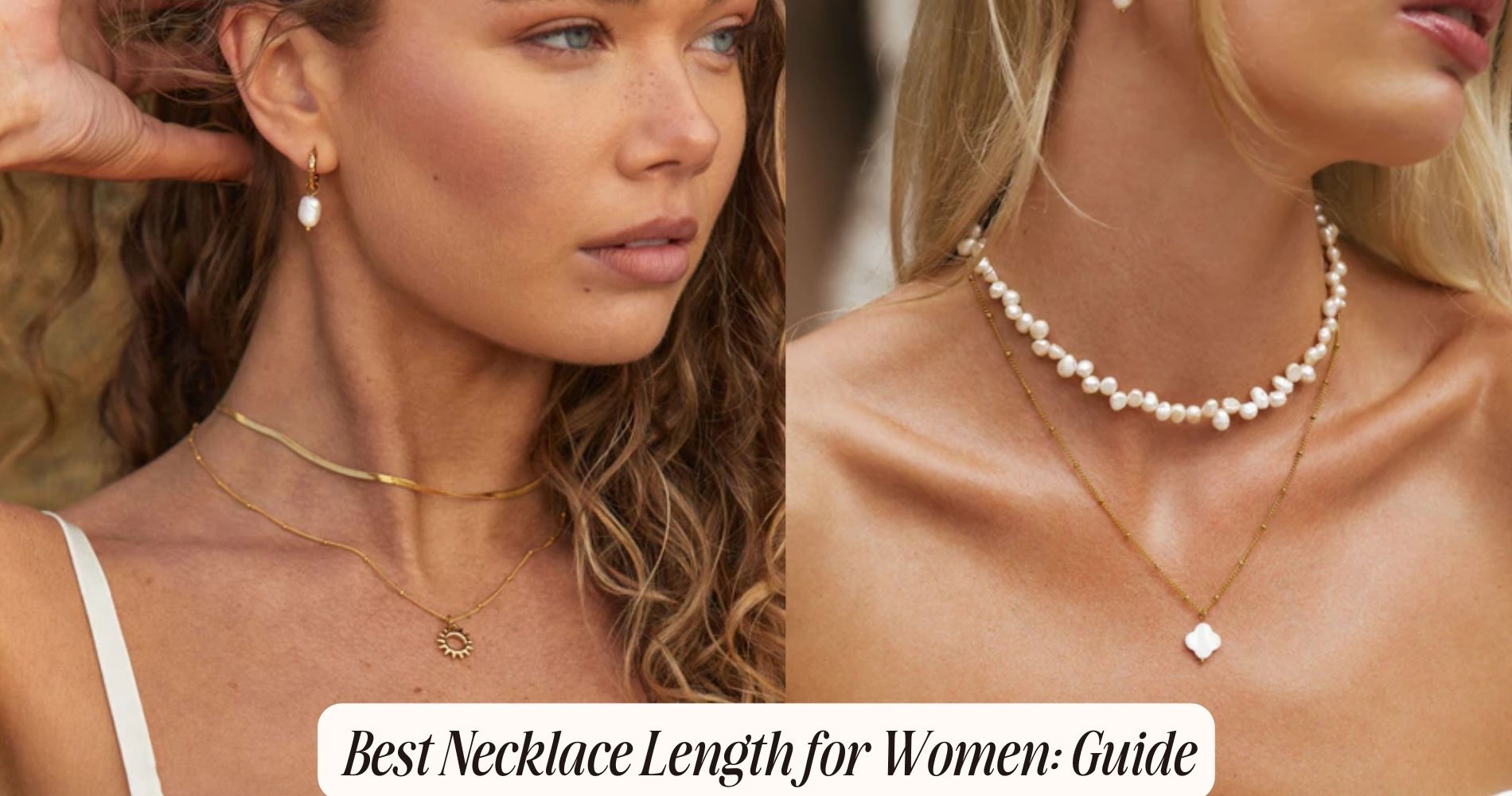
What is a Good Size for a Pendant?
When considering what is a good size for a pendant, think about your style and the look you want to achieve. For a bold statement, opt for larger pendants around 2 inches. For subtle elegance, choose something between 0.5 to 1 inch. Balance is key; the pendant should enhance your outfit without overwhelming it. Align your selection with current trends or your personal preference for a timeless effect. Also, ensure the pendant complements your neckline and frame to achieve a cohesive appearance. If you're intrigued by how to harmonize different elements and trends, explore our Long Pendant Necklace collection.
Understanding Pendant Dimensions
When selecting the perfect pendant, understanding its dimensions is essential to achieving the desired look and functionality. The size of a pendant can greatly influence its visual impact and how well it complements your overall style.
Start by considering the pendant shapes. Each shape—be it a vital teardrop, a geometric square, or an elegant oval—carries its own aesthetic and can either enhance or clash with your attire. For instance, a large circular pendant may be the statement piece you need, while a smaller, rectangular design might offer subtle elegance.
Custom engravings also play an important role in determining the pendant's dimensions. Engravings can add sentimental value, but they require additional space, impacting the overall size. If you're opting for intricate designs or detailed messages, make sure that the pendant is large enough to accommodate them without compromising readability.
Keep in mind that trends are leaning towards bold, oversized pendants, but balance is key. A pendant should neither overwhelm your neckline nor get lost in your ensemble.
Measuring Neckline Fit
To guarantee your pendant complements your outfit perfectly, accurately measuring the fit against your neckline is crucial. Start by understanding your neckline and how it interacts with your pendant. Different necklines, such as V-neck, scoop neck, or boat neck, necessitate specific neckline measurements to ensure fit accuracy.
First, measure the length of your necklace. Use a soft measuring tape, placing it around your neck where you intend the pendant to rest. Note down the measurement. This helps in determining how the pendant will fall and align with your outfit.
Next, consider the drop of the pendant. Measure from the base of your neck to the point where the pendant will naturally sit. For precision, ensure this distance complements the neckline of your chosen top or dress. For instance, a longer pendant works well with deeper necklines, while shorter pendants suit higher necklines.
Additionally, account for the pendant's width. A wider pendant may require more space around the neckline to avoid looking crowded. Therefore, matching a pendant's dimensions with your neckline measurement ensures a balanced and stylish look.
Proportional Necklaces
You'll achieve a balanced look by matching your pendant size with the appropriate chain length and considering your outfit's neckline.
Opt for a shorter chain with smaller pendants for a minimalist style, or a longer chain with larger pendants for a statement piece.
Always coordinate your necklace with your attire to make sure it complements rather than overwhelms.
Balancing Pendant Proportions
Attaining the ideal balance in pendant proportions guarantees that your necklace complements your neckline and overall attire seamlessly. Your pendant should serve as the focal point, drawing attention and creating a visual impact without overwhelming your look. To achieve this, consider the size of the pendant in relation to your body frame and the neckline of your outfit. A larger pendant can create a bold statement, while a smaller, more delicate piece offers subtle elegance.
When pairing your pendant with various necklines, it's crucial to make sure that the proportions enhance rather than detract. For instance, a V-neck top pairs well with a pendant that mirrors the V shape, whereas a round neckline suits a pendant with a softer, circular design. The harmony between the pendant and your attire can elevate your overall style.
Stay aware of current trends, which often emphasize minimalism and geometric shapes. However, never compromise personal taste for trends. Proportion is key: a well-balanced pendant should always complement your look, not compete with it.
Chain Length Considerations
Often, the length of your necklace chain plays a significant role in ensuring that your pendant sits perfectly and enhances your overall look. Selecting the right chain length is important because it dictates where the pendant will rest on your chest, influencing the visual impact.
For a balanced appearance, consider the proportions of your pendant relative to the chain length. A shorter chain of 16-18 inches works well with smaller pendants, keeping them close to your neckline, while longer chains of 20-24 inches suit larger, bolder pendants.
Layering techniques are another essential consideration. When layering necklaces, make sure that each chain varies in length to create a cascading effect. This not only prevents the chains from tangling but also allows each pendant to stand out.
Match the metals of your chains and pendants to maintain a cohesive and polished look—mixing metals can sometimes work, but it requires a keen eye for balance and style.
Outfit Coordination Tips
Coordinating your necklace with your outfit involves balancing the pendant size with the neckline and overall style to create a harmonious look. For instance, a large statement pendant works well with a simple, solid-colored dress, letting the necklace be the focal point. On the other hand, a delicate, small pendant complements a busy, patterned top without overwhelming it.
When considering outfit styles, the key is essential. For a plunging neckline, a longer chain with a medium to large pendant enhances the elongated effect. High necklines pair beautifully with shorter chains and smaller pendants, adding a touch of elegance without cluttering the neckline.
Occasion dressing also plays an important role. For formal events, opt for sophisticated, understated pendants that exude class without stealing the spotlight. Think elegant pearls or minimalist designs. Casual occasions offer more flexibility, allowing you to experiment with bold, eye-catching pendants that express your personality.
Always assess the outfit's fabric and texture. A chunky pendant might snag delicate materials, while a sleek pendant will glide effortlessly on smooth fabrics.
Pendant Size for Chains
When selecting a pendant, consider how chain length impacts its overall appearance. Aim for a pendant size that complements the chain length, ensuring a balanced look.
Stick to proportion guidelines: a smaller pendant for shorter chains and larger pendants for longer ones to maintain visual harmony.
Chain Length Impact
Selecting the appropriate chain length is essential for accentuating the pendant's size and overall aesthetic. When choosing your chain, consider the chain thickness. A thicker chain provides a sturdy base and can balance larger pendants, ensuring they hang correctly without overwhelming your neckline.
Conversely, thinner chains are delicate and best suited for smaller, lighter pendants, creating an elegant, minimalist look.
Layering options also play a vital role in your decision. If you plan to layer multiple necklaces, varying chain lengths can add depth and interest to your ensemble. For instance, pairing a shorter, thicker chain with a small pendant, alongside a longer, thinner chain with a larger pendant, can create a harmonious and fashionable look.
This layered approach is currently trending and allows for more versatility in showcasing your jewelry collection.
Pendant Proportion Guidelines
Achieving the perfect balance between your pendant and chain involves understanding pendant proportion guidelines to guarantee your jewelry looks cohesive and stylish.
Start by considering the pendant shapes. For instance, circular pendants often pair well with shorter chains, emphasizing their symmetry and centrality.
Conversely, elongated pendant shapes, like teardrops or vertical bars, generally look better on longer chains, creating a sleek, vertical line that complements your outfit.
Staying updated on size trends is important. Currently, oversized pendants are making a bold statement in the fashion world, but they require a sturdy chain to support their weight and maintain balance.
If you prefer a more minimalist look, small and delicate pendants are timeless and versatile, often best showcased on thin, shorter chains.
Precision in choosing the right chain length is essential. For a pendant that's 1 to 2 inches in size, a chain length of 18 to 24 inches usually works well.
However, for larger pendants, consider a chain that's at least 30 inches long to avoid overcrowding your neckline. Always make sure the chain isn't too thin, as it must carry the pendant's weight without looking fragile.
Balancing Style and Size
Striking the right balance between style and size in a pendant requires a keen understanding of both personal aesthetics and current fashion trends. Your personal preference plays a pivotal role in determining the ideal pendant size.
If you favor minimalist designs, opting for smaller, dainty pendants will align with your style. On the other hand, if bold and dramatic statements are your thing, larger, eye-catching pendants will be more suitable.
Keeping an eye on jewelry trends can also guide your decision. Currently, oversized pendants are making a significant comeback, often seen in fashion runways and celebrity styles. However, classic, medium-sized pendants remain timeless and versatile, fitting various occasions and outfits effortlessly.
When balancing style and size, consider the pendant's purpose. For everyday wear, a medium-sized pendant offers a practical blend of elegance and comfort. Special occasions might call for something more extravagant, where size can enhance the pendant's impact.
Ultimately, the key is to harmonize your personal preference with prevailing jewelry trends. This ensures your pendant not only complements your wardrobe but also resonates with contemporary fashion sensibilities, striking a perfect balance between style and size.
Frequently Asked Questions
How Do Pendant Sizes Affect Overall Outfit Aesthetics?
Pendant sizes greatly impact your outfit's overall aesthetics. Choose a pendant that's compatible with your neckline and harmonizes with your chain length. Proper selection guarantees a balanced look, enhancing your style with precision and trend awareness.
Can Pendant Shapes Influence Perceived Size?
Yes, pendant shapes can influence perceived size. Certain shapes create a visual impact that makes them seem larger or smaller. This optical illusion can enhance your outfit, making the pendant a focal point or a subtle accent.
Are There Cultural Considerations for Pendant Sizes?
Yes, cultural symbolism and historical significance play essential roles in pendant sizes. In some cultures, larger pendants signify status or protection, while smaller ones hold spiritual meanings. Stay aware of these trends to make informed choices.
Do Pendant Sizes Vary for Different Occasions?
Yes, pendant sizes do vary for different occasions. For occasion selection, consider event-specific trends: larger pendants suit festive or evening events, while smaller, understated pieces are ideal for professional or casual settings.
How Do Age and Gender Impact Pendant Size Preferences?
Age groups and gender trends notably impact pendant size preferences. Younger individuals often prefer smaller, delicate pendants, while older age groups lean towards larger, statement pieces. Men typically choose more substantial designs, whereas women favor diverse styles.
Conclusion
Choosing the right pendant size hinges on understanding dimensions, measuring for neckline fit, and ensuring proportionality with your chain. Consider your style, the pendant's material, and weight to strike the perfect balance.
Customization offers a tailored touch, while popular sizes provide a safe bet. Keep these expert tips in mind, and you'll confidently select a pendant that complements your look and space.
Stay trendy and precise in your choices for a polished, stylish finish.























Leave a comment
This site is protected by hCaptcha and the hCaptcha Privacy Policy and Terms of Service apply.